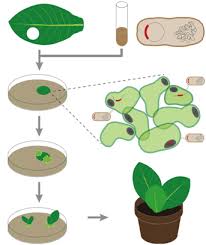Transgenic Plants-Development And Advantages
Transgenic plant is one of the most important applications of biotechnology, which is the branch of science that refers to modification of living organism for useful purposes. In normal course, plants acquire genes through pollination. In a transgenic plant, one or more genes are artificially inserted to alter the characteristics of the plant and crop. The genes inserted to alter the normal characteristic are called transgenes and they come from another unrelated plant or from a completely different species. BT cotton is an example of a transgenic plant.
How is the transgenic plant BT cotton developed?
Plants prepared by employing transgenes are called genetically modified (GM) plants. BT cotton is the most famous transgenic plant and GM crop. Bascillus Thuringiensis (Bt) is a soil-dwelling bacterium. Bt is widely used as a biological pesticide. It appears in the gut of moths and butterflies, on leaf surfaces etc. In GM cotton, Bt is employed to make the crop pest resistant. After this modification, GM plant produces its own pesticide and the cotton plant acquires the power to save itself from the pest known as ‘ball worm.’
What is genetic engineering?
In transgenic plants, recombinant DNA technique is used to create plants with desired features. Application of this technique is called genetic engineering. Genome is a complete set of genes or genetic sequence present in a cell or organism. In recombinant DNA technique, genome of an organism is modified. Recombinant DNA is a technology through which a foreign gene of an organism is inserted into another organism to produce desired characteristics. This gene can even be from totally unrelated organism.
This technology supports identification and isolation of genes causing specific characteristic in one kind of organism and moving copies of said genes into another different organism to generate the desired features.
Advantages of transgenic plants
In a transgenic plant, a plant breeder tries to improve quality and yield of the crop by inserting genes. He tries to make the plant more productive. The following features can be produced by employing appropriate genes.
• Transgenic plants can be made to produce higher yield with better resistance to diseases, droughts etc.
• Transgenic plants are capable of producing crops with better nutritional value. Beta-Carotin taken from daffodils is inserted into rice to produce golden rice. Beta-Carotin gets converted to vitamin A and the golden rice is used to prevent nutritional blindness which is caused by deficiency of vitamin A. The presence of Beta-Carotin rice changes its colour from pearly white to pale yellow, thus giving the name.
• The crops developed by GM plants have improved shelf life, making storage and transportation easier.
• GM crops have better withstanding capacity against diseases, reducing dependence on pesticides. This minimizes pesticide residues in food, water and soil.
Transgenic plant breeding Vs Traditional plant breeding
In traditional plant breeding, same species or closely related species are used to artificially cross plants. It is difficult to transfer gene of a plant to completely unrelated plant through traditional plant breeding. But in transgenic plant breeding, genes from entirely different species, microorganisms or plants can be used to develop plants capable of producing desired result.









